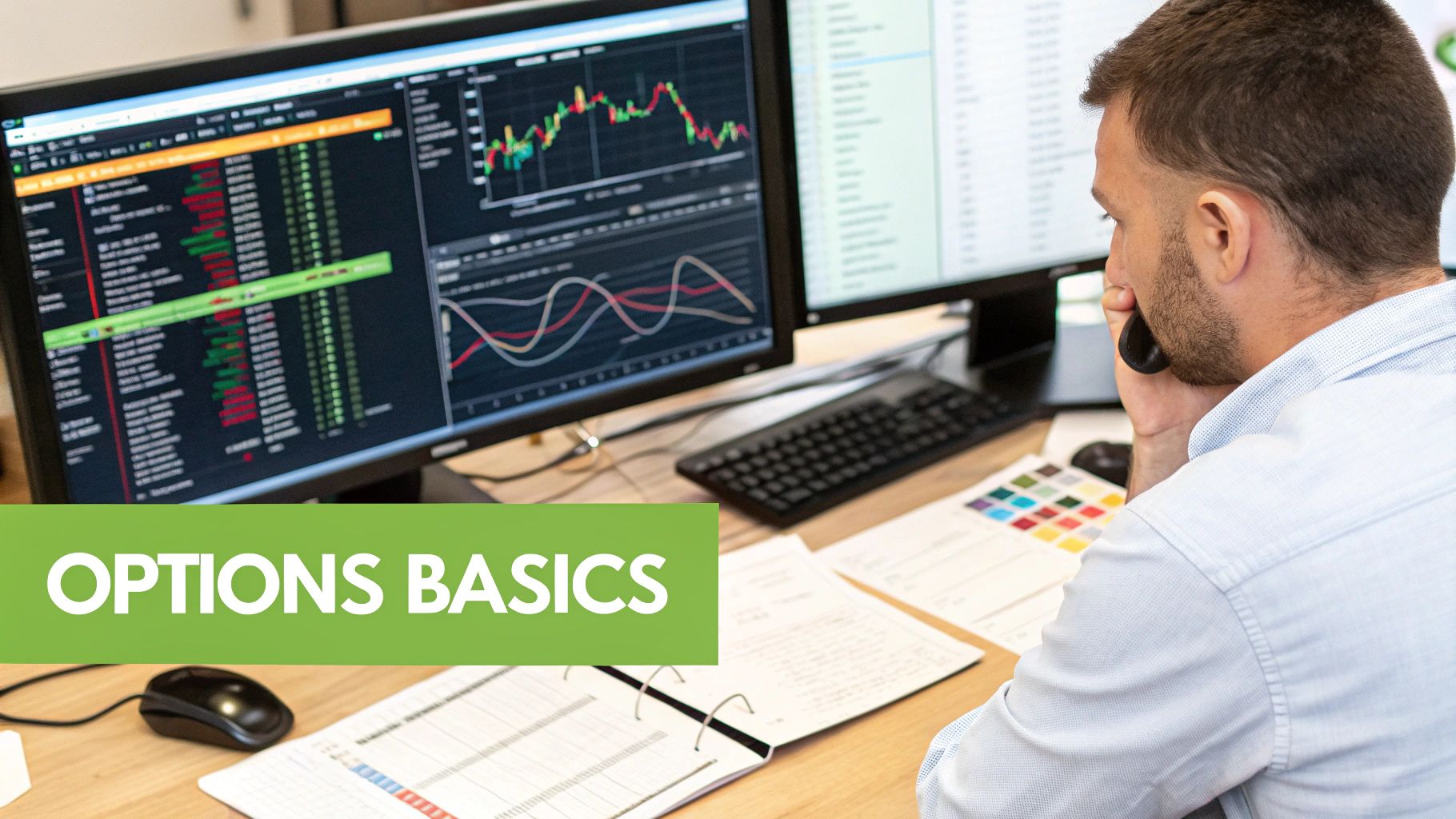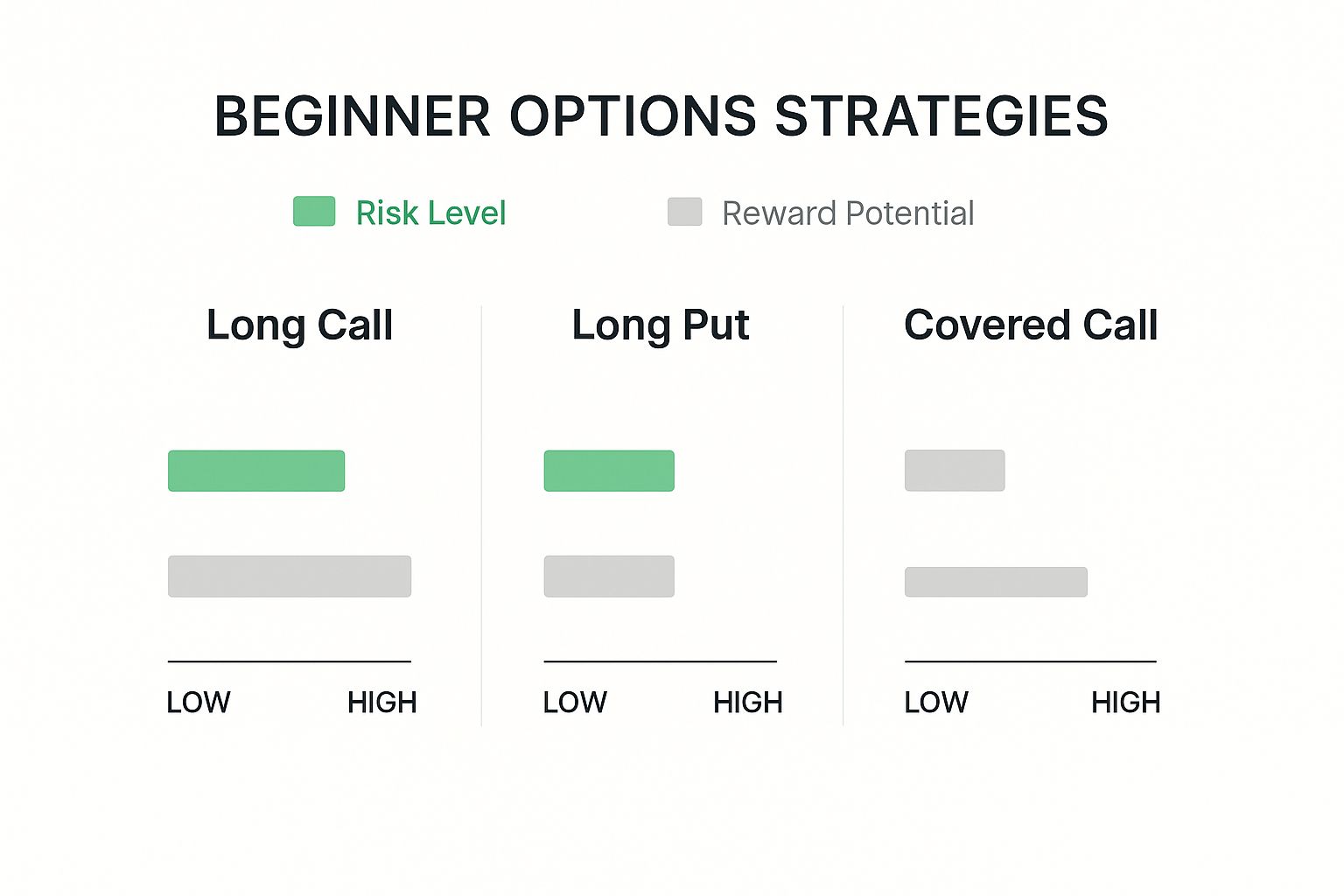Options Trading for Beginners: Your Complete Strategy Guide
If a stock moves past your strike, the option can be assigned — meaning you'll have to sell (in a call) or buy (in a put). Knowing the assignment probability ahead of time is key to managing risk.
Posted by
Related reading
A Practical Guide to Generating Income with Covered Call Options
Learn how to generate consistent income using covered call options. This guide breaks down the strategy, risks, and rewards with real-world examples.
Selling Naked Put (selling naked put): A Practical Guide to Income and Risk
Discover how selling naked put options can generate consistent income while managing risk. Practical strategies, real-world examples, and step-by-step guidance.
Risks of Covered Calls: risks of covered calls explained
Discover the risks of covered calls and how to navigate gains limits, assignment pitfalls, and smarter income strategies to protect your portfolio.
Welcome to Options Trading: Why This Changes Everything

Imagine snagging a reservation at that trendy new restaurant everyone's talking about. You pay a small fee to secure your spot, right? But what if something comes up? Maybe a better offer appears, or your plans change. You can simply let the reservation go. That flexibility, that option to choose, is the heart of options trading.
You're essentially buying the right, not the obligation, to buy or sell something—like a stock—at a set price. This is a game-changer for new investors. Why? Because options offer more control and potentially bigger returns with less initial investment than traditional stock trading.
Let's say you think a company's stock is about to take off. Instead of buying 100 shares outright, you could buy a call option. Think of it as a ticket that gives you the right to buy those shares at a specific price (the strike price) before a certain date (the expiration date). If the stock price climbs, your option becomes more valuable, and you can sell it for a profit. If the price drops, you just let the option expire, losing only the small fee you paid – much like forfeiting your restaurant reservation.
This flexibility is a big draw for many investors. In fact, the options market has grown tremendously in recent years. From 2021 to 2022, trading volume shot up to over 10 billion contracts – a 32.2% jump! This growth shows just how popular and accessible options trading has become. Discover more insights
Why Options Are Different (and Better)
Traditional stock investing can feel limiting. You buy a stock hoping it goes up. If it doesn’t, well, you’re stuck. Options trading opens up a whole new world of possibilities. With put options, you’re essentially buying insurance against a stock price drop, like getting a comprehensive policy for your car.
Plus, options let you profit in various market conditions—up, down, or even sideways. You can tailor your approach based on your market outlook and how much risk you're comfortable with. You can also use blogging tools to enhance your analysis and strategy development.
This versatility is what makes options trading so attractive for beginners. It’s not just about speculation; it’s about managing risk strategically and maximizing potential profits in ways you simply can’t with traditional stock trading. It's about having more tools to help you reach your financial goals.
Understanding Options: Your Financial Swiss Army Knife

The screenshot above from Investopedia describes options contracts. It highlights how they give you rights, but not obligations. This flexibility is a big plus for new options traders, offering a way to manage risk and potentially boost returns.
Let's break down options trading for beginners. Imagine options as a Swiss Army Knife. Each tool has a unique purpose, and knowing when to use which one is key.
Call Options: Your Ticket to Potential Profits
Think of a call option as a reservation for a concert ticket. You pay a small fee (the premium) for the right – but not the obligation – to buy the ticket (the underlying asset) at a fixed price (the strike price) before a certain date (the expiration date).
If the band gets super popular and ticket prices skyrocket, your reservation becomes valuable. You can either buy the ticket at the original, lower price, or sell the reservation itself for a profit. If the band flops, you can just let the reservation expire, losing only the small premium.
Call options work similarly with stocks. If the stock price goes above the strike price, your call option is in the money. You then have the right to buy the stock at the lower strike price. You can either exercise that right or sell the option contract for a profit, making money from the price difference.
Put Options: Your Insurance Policy Against Losses
A put option acts like insurance. Think of insuring your car. You pay a premium for the right to sell your damaged car at a predetermined value, regardless of its actual post-accident worth. A put option gives you the right to sell a stock at the strike price, even if the market price falls below it.
Let's say you own company shares and worry about a price drop. Buying a put option acts as a hedge, protecting you if the price falls. If the price stays above the strike price, you let the put option expire, just like an unused insurance policy. This risk management is a big advantage of options trading for beginners.
Intrinsic and Time Value: Understanding the Value Drivers
Options have two main value components: intrinsic value and time value. Think of a classic car. Intrinsic value is like its current scrap value – what it's worth now. Time value is like its potential value after restoration – the added value from future potential.
For options, intrinsic value is the difference between the current stock price and the strike price (if the option is in the money). Time value represents the possibility of further price changes before expiration.
The Retail Revolution: How Regular Traders Are Winning
The options trading world isn't just for Wall Street anymore. Everyday investors are stepping onto the field, equipped with new technology and easily accessible information. This shift has opened doors to tools and opportunities that used to be exclusive.
This isn't just a trend; it's a real change. Retail participation in options trading has exploded, especially since the COVID-19 pandemic. As of July 2022, retail traders made up 48% of all options market activity. Even more impressive, they handle 51% of trades in short-dated options (contracts expiring within a week). This shows a major advantage for retail traders: they're quick on their feet with short-term strategies. Discover more insights
Why Retail Traders Excel in Short-Term Options
Individual traders have a secret weapon in the fast-moving world of short-term options: speed and flexibility. Large institutions, slowed down by complex decision-making, can struggle to keep up with sudden market shifts. Retail traders, however, can adapt quickly and seize those fleeting opportunities. This agility is especially valuable in short-dated options where fast decisions can lead to big profits.
Think of it like this: a sudden news event impacts a company's stock price. A retail trader, watching the market live, can instantly execute an options trade to profit from the expected price movement. A large institution, bogged down by internal processes, might miss the chance entirely.
Leveraging Technology and Data
The tech boom in finance has fueled the rise of the retail trader. Powerful trading platforms, sophisticated charting software, and real-time market data are now at everyone's fingertips. Options, much like financial models in Excel, are versatile tools. This access to information allows retail traders to make smart decisions and compete effectively. Platforms like Strike Price offer data-driven probabilities for different strike prices, helping newcomers understand the potential risks and rewards.
There's also a wealth of educational resources available now. Online courses, webinars, and blog posts offer valuable guidance for new traders. This increased access to knowledge has taken the mystery out of options trading, making it accessible to a wider audience. With the right tools and education, regular investors can navigate the options market and reach their financial goals. It's not about outsmarting Wall Street; it's about playing to your strengths as an individual trader.
Beginner-Friendly Strategies That Actually Work
Forget complicated options strategies. Let's talk about two simple, yet effective approaches that beginners can use right away: covered calls and cash-secured puts.
Covered Calls: Generating Income on Existing Stocks
Think of covered calls like renting out a property. You already own the property (your stocks), and you collect rent (premiums) for letting someone else have the right to buy it (your stocks) at a certain price (the strike price) by a specific date. For a more in-depth look, check out our guide on how to write covered calls.
Let's say you own 100 shares of Company XYZ, currently trading at $50. You decide to sell a covered call with a strike price of $55 expiring in a month. You receive a $1 premium per share, totaling $100. If the stock price stays below $55, you keep your shares and the $100 premium. If it goes above $55, your shares are sold, but you still profit from the price difference and the premium.
Cash-Secured Puts: Buying Stocks at a Discount
Imagine you're looking to buy a house and you put in a bid at a lower price than the asking price. You set aside the cash needed to buy the house (this "secures" the put). If the seller accepts, great! You get the house at a discount. If not, you keep your cash.
Cash-secured puts work similarly. You sell someone the right to sell you 100 shares of a stock at a specific strike price. You collect a premium for this. If the stock price stays above the strike price, you keep the premium. If the stock price falls below the strike price, you buy the shares, but at your discounted price.
Comparing Beginner Strategies
Before we dive deeper, let's compare a few beginner-friendly strategies. The infographic below illustrates the risk and reward potential of Long Calls, Long Puts, and Covered Calls.

As you can see, Covered Calls offer a more balanced risk-reward profile than Long Calls and Puts. This makes them a good choice for generating income on stocks you already own. Cash-secured puts, on the other hand, are an excellent way to potentially buy stocks at a lower price than the current market value. Both strategies are a great starting point for building your options trading knowledge.
To help you further compare these beginner strategies, let's look at a table summarizing their key characteristics:
To help you choose the best strategy for your needs, the table below compares covered calls and cash-secured puts across several important factors.
Beginner-Friendly Options Strategies Comparison
| Strategy | Risk Level | Profit Potential | Best Market Conditions | Capital Required |
|---|---|---|---|---|
| Covered Calls | Limited (potential loss capped by stock ownership) | Moderate (premium + potential stock appreciation up to strike price) | Neutral to slightly bullish (best for generating income on existing holdings) | Cost of owning 100 shares of the underlying stock |
| Cash-Secured Puts | Defined (maximum loss is strike price x 100 - premium received) | Moderate (premium + potential stock appreciation if assigned) | Neutral to slightly bearish (best for acquiring shares at a discount) | Cash equal to the strike price x 100 |
This table highlights the key differences and similarities between covered calls and cash-secured puts. Covered calls offer a lower risk profile as your potential loss is limited by your existing stock ownership. Cash-secured puts have a defined risk, with the maximum loss being the strike price multiplied by 100, less the premium received. Both strategies offer moderate profit potential and are suitable for different market conditions depending on your investment goals. Remember, understanding these nuances can help you make more informed trading decisions.
Risk Management: Your Trading Safety Net

Think of options trading like driving a car. You want to reach your destination (profit), but you also need to be prepared for unexpected bumps in the road (losses). Risk management is your seatbelt—it won't prevent all accidents, but it can significantly reduce the damage. It's the key to surviving the inevitable ups and downs and becoming a successful trader.
Position Sizing: Protecting Your Capital
One of the first rules of the road is controlling your speed. In trading, that's position sizing—how much of your capital you risk on each trade. The 1% rule is a good starting point for beginners: never risk more than 1% of your total trading capital on any single trade.
So, if you have a $10,000 account, you shouldn't risk more than $100 on a single trade. This disciplined approach keeps losses small and prevents a few bad trades from wiping you out. It allows you to stay in the game long enough to learn and grow.
Exit Strategies: Knowing When to Fold
Just like knowing when to take an alternate route, knowing when to exit a trade is essential. This is where exit strategies come into play. You need a plan for both winning and losing trades.
Set a target price for taking profits and a stop-loss level to limit potential losses. These pre-determined exit points help you stay disciplined and avoid emotional decisions, which can often lead to bigger losses. Remember, the goal isn't to win every trade, but to manage your risk effectively over the long haul.
The Pitfalls of Paper Trading
Many new traders start with paper trading, practicing with virtual money. It's like using a driving simulator—it helps you learn the controls, but it doesn't fully prepare you for real-world conditions.
Paper trading lacks the emotional intensity of real money. Fear and greed can significantly influence your decisions when your own capital is on the line. While paper trading is helpful for learning the mechanics, be aware of its limitations.
Learning from Experience: Wins and Losses
Every trade, whether a win or a loss, is a learning opportunity. Just as experienced drivers learn from near misses, reviewing your past trades can help you refine your strategy. Understand what worked, what didn't, and why. Tools like an options risk-reward calculator can help you analyze the potential risks and rewards of a trade before you enter it.
Even the best traders have losing trades. The key is to learn from those experiences and improve your risk management. It's a continuous process of learning and adapting.
Managing Your Emotions: The Psychological Game
Trading psychology is just as important as technical analysis. Fear and greed can lead to impulsive decisions, like speeding through a yellow light. Developing emotional discipline is crucial for successful trading.
Techniques like mindfulness and journaling can help you become more aware of your emotional state and its impact on your decisions. This self-awareness can help you stay calm and rational, even during market volatility.
Before we move on, let's summarize some key risk management rules for beginners:
Risk Management Rules for Options Beginners
| Rule | Recommended Limit | Reasoning | Example Scenario |
|---|---|---|---|
| Position Sizing (1% Rule) | 1% of total trading capital per trade | Limits potential losses from any single trade | $10,000 account, maximum $100 risk per trade |
| Stop-Loss Orders | Pre-defined exit point | Minimizes losses if the trade moves against you | Exit a trade if it drops 10% from your entry price |
| Define Profit Targets | Pre-defined exit point | Secure profits and avoid greed | Exit a trade when it reaches a 20% profit |
| Diversification | Spread investments across different assets | Reduces the impact of any single losing trade | Don't put all your eggs in one basket |
| Continuous Learning | Regularly review and analyze trades | Identify mistakes and improve strategies | Track your wins and losses to understand your trading patterns |
By following these guidelines, you can build a strong foundation for managing risk and navigating the exciting world of options trading.
Trading Options From Anywhere: The Global Opportunity
The options trading world isn't confined to Wall Street anymore. Thanks to the internet, anyone with a connection can participate, opening up a wealth of opportunities for beginners everywhere.
Understanding Global Trading Centers and Their Impact
While financial hubs like New York, London, and Tokyo remain important, we're seeing more and more trading activity in emerging markets like South Asia and Sub-Saharan Africa. This shift is changing the landscape for new investors. Discover more insights.
Because these trading centers operate in different time zones, markets are open around the clock. This 24-hour cycle influences both option pricing and liquidity (how easily you can buy or sell). Understanding these time differences is key, especially when you're just starting out.
Navigating Time Zones and Market Overlaps
When multiple exchanges are open at the same time, it creates market overlaps. This can mean better pricing and higher liquidity, making it easier to buy and sell. But juggling trades across different time zones requires careful planning.
Think of a trader in Asia. They can use the overlap between the Asian and European markets to their advantage, getting in or out of trades with higher liquidity. On the flip side, trading when fewer markets are open can mean wider bid-ask spreads (the difference between the buying and selling price), making trading more expensive.
Practical Considerations for International Traders
If you're trading across time zones, setting alerts is crucial. Imagine holding an option on a European company while you’re in the US. Overnight news in Europe can dramatically affect your option's price. Real-time alerts let you react quickly and manage your risk.
Also, you need to understand the rules. Different countries have different regulations about options trading. Choose a broker that offers global access but also follows your local rules. Prioritize safety and reliability with your broker, especially for international trades. This keeps your funds safe and ensures smooth transactions. With these considerations in mind, beginners can confidently explore the global options market and its many opportunities.
Essential Tools: Building Your Trading Command Center
Success in options trading for beginners depends on the right tools and knowing how they work. This isn't about expensive software; it's about a system that fits your trading style and helps you make smart choices.
Brokerage Platforms: Your Trading Foundation
Your brokerage platform is your home base. It's where you make trades, manage your account, and see important market information. Look for a platform that's easy to use, executes orders reliably, and gives you access to the options markets you want. Many brokers offer charting tools, research, and educational resources all in one place, which is perfect for beginners.
Analysis Tools: Gaining an Edge
For a comfortable and efficient setup, explore ergonomic office accessories. Beyond the basics, specialized analysis tools can really improve your decisions. Probability calculators, like the ones on Strike Price, can be incredibly helpful. They show the mathematical likelihood of different outcomes, so you can weigh potential risks and rewards before using your capital.
This Strike Price screenshot shows how the platform displays probability calculations for different options contracts. Seeing the potential profit and loss probabilities clearly helps traders make informed choices based on their risk tolerance. This data-driven approach removes the guesswork from options trading, giving beginners more confidence.
Also, think about using volatility tracking tools. Volatility, which measures price swings, is key to options pricing. Understanding how volatility affects your trades can make all the difference.
Staying Informed: Alerts and Notifications
Staying updated on market moves and key events is crucial in options trading. Earnings calendars help you anticipate volatility and plan trades around company news. Options flow data, showing what big traders are doing, can offer valuable insights. But too much information can be overwhelming. Use targeted alerts and notifications to stay informed without getting buried in data. Focus on what's relevant to your open positions and watchlist. Mobile trading apps give you convenient access to your portfolio and alerts, so you're always connected.
Building Your Personalized System
Building your trading setup is a personal journey. Try different tools and find what suits you best. Start with the basics and add more advanced resources as you learn. The goal is a system that empowers you to make smart, confident choices in options trading.
Ready to level up your options trading? Start a free trial with Strike Price and see how data-driven probabilities can change your trading. Start Your Free Trial